
Myanmar, officially the Republic of the Union of Myanmar, also known as Burma, is a country in Southeast Asia. It is the largest country by area in Mainland Southeast Asia, and has a population of about 54 million as of 2017. Myanmar is bordered by Bangladesh and India to its northwest, China to its northeast, Laos and Thailand to its east and southeast, and the Andaman Sea and the Bay of Bengal to its south and southwest. The country's capital city is Naypyidaw, and its largest city is Yangon (Rangoon).
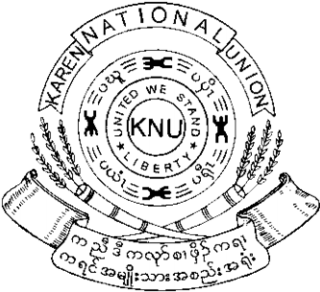
The Karen National Union is a political organisation with an armed wing, the Karen National Liberation Army (KNLA), that claims to represent the Karen people of Myanmar (Burma). It operates in mountainous eastern Myanmar, and has underground networks in other areas of Myanmar where Karen people live as a minority group. In the Karen language, this area is called Kawthoolei. Some of the Karen, led primarily by the Karen National Union (KNU), have waged a war against the central government since early 1949. The aim of the KNU at first was independence. Since 1976 the armed group has called for a federal system rather than an independent Karen State.

Human rights in Myanmar under its military regime have long been regarded as among the worst in the world. International human rights organisations including Human Rights Watch, Amnesty International, and the American Association for the Advancement of Science have repeatedly documented and condemned widespread human rights violations in Myanmar. The Freedom in the World 2011 report by Freedom House notes that "The military junta has... suppressed nearly all basic rights; and committed human rights abuses with impunity." In 2011 the "country's more than 2,100 political prisoners included about 429 members of the NLD, the victors in the 1990 elections." As of July 2013, according to the Assistance Association for Political Prisoners, there were about 100 political prisoners in Burmese prisons.
In Myanmar, terrorism is defined by the country's counter-terrorism law and its subsections, which is interpreted by the Anti-Terrorism Central Committee and enforced by the government of Myanmar. Two groups are currently listed as terrorist organisations in accordance with Myanmar's counter-terrorism law; the Arakan Rohingya Salvation Army (ARSA), which was added on 25 August 2017, and the Arakan Army, which was added on 18 January 2019. The SPDC military government called the Vigorous Burmese Student Warriors (VBSW) "terrorists" after their role in the 1999 Myanmar Embassy siege, but the group was never legally declared as such.
Insurgencies have been ongoing in Myanmar since 1948, the year the country, then known as Burma, gained independence from the United Kingdom. The conflict has largely been ethnic-based, with several ethnic armed groups fighting Myanmar's armed forces, the Tatmadaw, for self-determination. Despite numerous ceasefires and the creation of autonomous self-administered zones in 2008, many armed groups continue to call for independence, increased autonomy, or the federalisation of the country. The conflict is the world's longest ongoing civil war, having spanned more than seven decades.
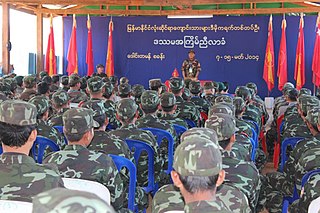
The All Burma Students' Democratic Front is an opposition group in Myanmar. It was founded on 1 November 1988, after the 8888 protests in Yangon. The group's leadership consists mostly of former student exiles.

The Kachin conflict or the Kachin War is one of the multiple conflicts which are collectively referred to as the internal conflict in Myanmar. Kachin insurgents have been fighting against the Tatmadaw since 1961, with only one major ceasefire being brokered between them, which lasted from 1994 to 2011, a total of 17 years.

The Arakan Army is an ethnic armed organisation based in Rakhine State (Arakan). Founded on 10 April 2009, the AA is the military wing of the United League of Arakan (ULA). It is currently led by commander in chief Major General Twan Mrat Naing and vice deputy commander Brigadier General Nyo Twan Awng.
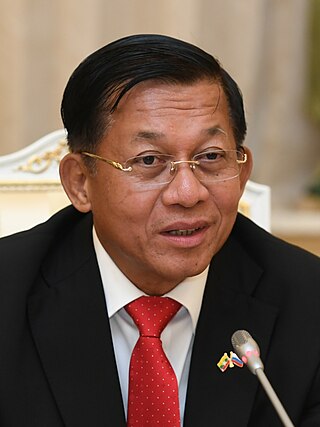
Min Aung Hlaing is a Burmese politician and army general who has ruled Myanmar as the chairman of the State Administration Council since seizing power in the February 2021 coup d'état. He took the nominally civilian role of prime minister of Myanmar in August 2021 upon the formation of the Provisional Government. He has also been the commander-in-chief of Defence Services since March 2011. He previously served as Joint Chief of Staff of the Ministry of Defence from 2010 to 2011 and was a member of the National Defence and Security Council (NDSC) chaired by the president of Myanmar.

The National Reconciliation and Peace Centre, formerly known as the Myanmar Peace Centre, was an organization to provide technical support to the peacemaking process in Myanmar (Burma), including implementing and managing ceasefire agreements and facilitating dialogue on political issues. The centre was renamed the NRPC in July 2016, with the promulgation of Order 50/2016 by President Htin Kyaw. The centre was dissolved in February 2021 by authorities, in the aftermath of the 2021 Myanmar coup d'etat.
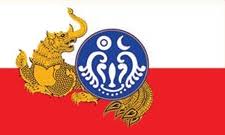
The Arakan National Party, is a political party in Myanmar (Burma), representing the interests of the Rakhine people in Rakhine State and Yangon Region. The party was founded on 13 January 2014 and registered with the Union Election Commission on 6 March 2014. The chairman of the ANP is Thar Htun Hla. The party is known for its hardline ethnic nationalist stance, as well as its Islamophobic and anti-Rohingya positions. Some members of the party were involved in instigating violence against Rohingya people during the communal riots in 2012, which left dozens dead and thousands homeless.

The United Nationalities Federal Council is a coalition of five opposition groups in Myanmar. In 2011, the council was formed by 11 opposition groups that campaigns for the rights of various ethnic minorities in Myanmar. Six of the UNFC's members have successfully made or are in the process of making peace negotiations and permanent ceasefire agreements with the government. The group's armed wing is the Federal Union Army (FUA).

The Mon National Liberation Army is a Mon insurgent group in Myanmar (Burma). It is the armed wing of the New Mon State Party (NMSP), and has been fighting government forces since 1949, though under different names. The NMSP signed the Nationwide Ceasefire Agreement (NCA) on 15 October 2015 with several other insurgent groups and the government of Myanmar.

Border Guard Forces are subdivisions of the Tatmadaw consisting of former insurgent groups in Myanmar under the instruction of Regional Military Commands. The government announced its plan to create Border Guard Forces in April 2009, in the hopes of ending hostilities between the government and insurgent groups leading up to the 2010 general election.

The Rohingya genocide is a series of ongoing persecutions and killings of the Muslim Rohingya people by the Burmese military. The genocide has consisted of two phases to date: the first was a military crackdown that occurred from October 2016 to January 2017, and the second has been occurring since August 2017. The crisis forced over a million Rohingya to flee to other countries. Most fled to Bangladesh, resulting in the creation of the world's largest refugee camp, while others escaped to India, Thailand, Malaysia, and other parts of South and Southeast Asia, where they continue to face persecution. The United States, United Kingdom, and other countries refer to the events as "ethnic cleansing".
Violent clashes have been ongoing in the northern part of Myanmar's Rakhine State since October 2016. Insurgent attacks by the Arakan Rohingya Salvation Army (ARSA) have led to sectarian violence perpetrated by Myanmar's military and the local Buddhist population against predominantly Muslim Rohingya civilians. The conflict has sparked international outcry and was described as an ethnic cleansing by the United Nations High Commissioner for Human Rights. In August 2017, the situation worsened and hundreds of thousands of refugees fled Myanmar into Bangladesh, with an estimated 500,000 refugees having arrived by 27 September 2017. In January 2019, Arakan Army insurgents raided border police posts in Buthidaung Township, joining the conflict and beginning their military campaign in northern Rakhine State against the Burmese military.

The Shanni Nationalities Army is a Shanni insurgent group active in northern Sagaing Region and Kachin State, Myanmar (Burma). It was founded as a group in 1989 but was transformed into an armed group in January 2016 by expelled Shanni members of the Kachin Independence Army. The SNA has five objectives – to gain statehood, to fight drugs, to establish a federal Union, to build unity among all Shan sub-groups, and to conserve ecological balance.
N'Ban La is a Kachin currently resistance leader in Myanmar. He is the chairman of the Kachin Independence Organisation (KIO) and a senior commander of the Kachin Independence Army (KIA), and was formerly the vice chairman of the KIO and the chairman of the United Nationalities Federal Council (UNFC).
Gunhtang Gam Shawng is a Kachin political and military leader. He is the vice chairman of the Kachin Independence Organisation (KIO) and the commander in chief of the Kachin Independence Army. Shawng was also previously the chief of staff of the KIO.
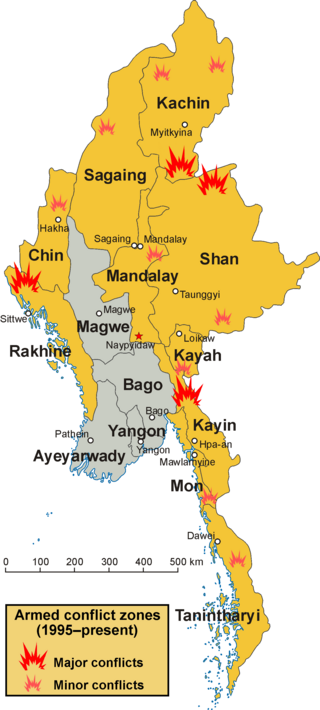
The Myanmar peace process refers to the nation led discussions aimed at relieving the internal armed conflict that has been simmering in Myanmar since before it gained independence from Britain in 1948. Many of the events that have taken place can be attributed to tensions surrounding the treatment of the numerous different ethnic minorities. This conflict involves both the Myanmar government and military, and the 16 armed ethnic minorities in Myanmar. In recent years tension between the Myanmar government and the military has been increasing, with the military still holding position as the most powerful political force in Myanmar.















